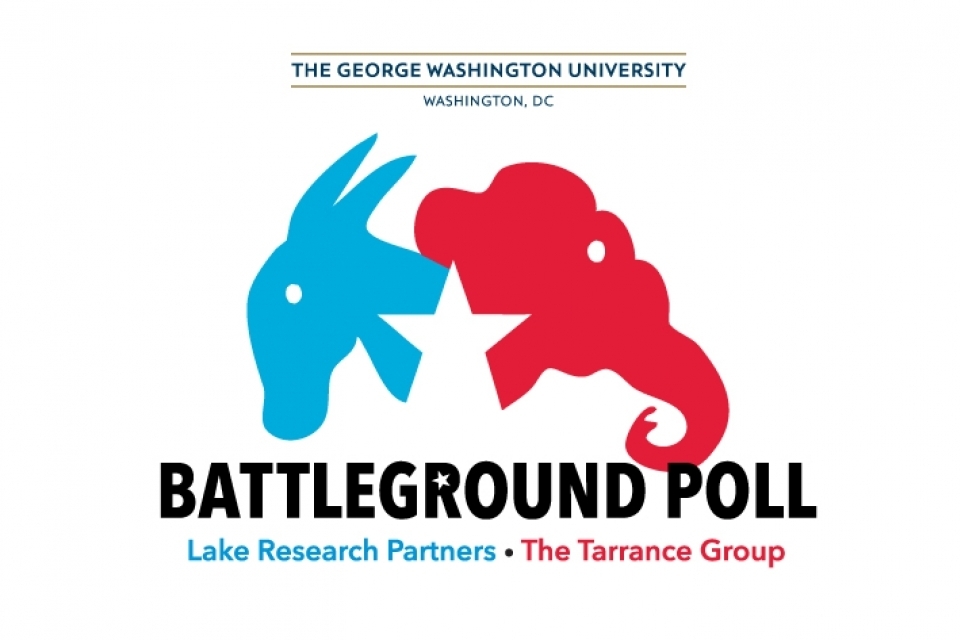The race for president has tightened considerably, according to the latest George Washington University Battleground Poll. The poll finds the race is about even, with 42 percent of likely voters supporting Democratic nominee Hillary Clinton and 40 percent supporting Republican nominee Donald Trump.
The narrow race reflects a conflicted electorate in which voters are weighing many options. Poll respondents were presented with several possibilities for how they may vote in November. Roughly one-quarter of them said that they would likely vote for a third-party candidate or vote for a candidate “from the other political party than the one that [they] usually support.” Thirteen percent said they might not vote at all, and 45 percent said they might split their tickets, voting for different parties for president and the rest of the ballot. Meanwhile, 59 percent of the likely voters surveyed said that they would “reluctantly” vote for the candidate of the party they usually support.
The bipartisan GW Battleground Poll, conducted in partnership with The Tarrance Group and Lake Research Partners, found that despite this lack of enthusiasm, Trump and Clinton supporters say that their choice is more of a vote for their preferred candidate (60 percent of Clinton voters versus 54 percent of Trump voters) than against the opponent (37 percent of Clinton supporters and 43 percent of Trump supporters). Slightly more voters held a favorable view of Mrs. Clinton (43 percent) compared with Mr. Trump (38 percent).
“Despite close numbers, Hillary Clinton is poised to win by dominating the issue dimensions of governing, caring, temperament and being for the middle class,” said pollster Celinda Lake, president of Lake Research Partners. “The key is to have voters focus on the true choice for the country.”
Differences Drawn Between Candidates
The poll asked voters about the two major contenders’ abilities to deal with issues and their personal characteristics. On the issues facing the country, the voters surveyed felt that Mrs. Clinton was better prepared to face challenges on the economy (51 percent to 46) and foreign affairs (55 percent to 40) and was the better choice to fight for the middle class (50 percent to 43). The candidates were essentially tied on jobs (49 percent to 47).
On questions of character, Mr. Trump was rated higher on “say[ing] what they believe” (59 percent to 30) and being “honest and trustworthy” (39 percent to 35 percent), and tied on being a “strong leader” (46 percent to 45). Mr. Trump fared poorly when asked if he or Mrs. Clinton better represents someone who “has the temperament needed to serve” (31 percent to 57). Despite Mr. Trump’s campaign raising the issue of Mrs. Clinton’s health, Mrs. Clinton narrowly edged out Mr. Trump when rating who “is healthy enough to be effective” (43 percent to 41). The edge is not outside the margin of error, however.
“One of the major factors keeping the race tilting towards Mrs. Clinton is the strongly unfavorable image of Mr. Trump,” said pollster Ed Goeas, president and CEO of The Tarrance Group. “What is particularly notable is that, in addition to the strongly negative views of expected opponents, Mr. Trump also has a majority unfavorable rating with voters whom his campaign has been targeting, like men (55 percent), white voters (51), middle class voters (59) and voters whose top issue concern is dysfunction in government (66).”
“Were Donald Trump a more traditional Republican candidate who was running a more traditional presidential campaign, this data suggests he could win by a notable margin,” Mr. Goeas said.
Economy Outweighs Immigration
No matter who wins the race for the White House, voters chose the economy (21 percent) and dysfunction in government (18 percent) as the most important issues for the next president to prioritize. Despite the higher profile of immigration as a campaign issue, only 7 percent of respondents identified it as the most important issue for the next president. (Mr. Trump’s meeting with Mexican President Enrique Peña Nieto occurred while the poll was in the field.)
“From a rhetorical perspective, Mr. Trump has tied immigration to the economy, government dysfunction, terrorism and more,” said Michael Cornfield, research director and associate professor at the GW Graduate School of Political Management. “That issue linkage helps explain how he prevailed over Republican rivals who campaigned more on the economy as a stand-alone issue and how he has gained recently on Clinton.”
Third-Party Candidates
Libertarian candidate Gary Johnson received double-digit support in a hypothetical four-way ballot; 10 percent of poll respondents would vote for the former New Mexico governor.
Of voters whose first choice was either Mr. Johnson or Green Party candidate Jill Stein, 34 percent would chose Mrs. Clinton in a head-to-head matchup of the two major-party candidates. Twenty-six percent would choose Mr. Trump. This willingness to choose major party candidates as alternatives indicates that negative impressions of Mrs. Clinton and Mr. Trump could be fueling higher third-party voter rates than may actually occur in November, Ms. Lake said.
On Terrorism, Economic Downturn
Beyond the race for president, Americans are less worried about terrorist attacks in the United States, despite recent global unrest, but they continue to hold a strong sense of economic anxiety. A 57 percent majority says that they are not worried that they or their immediate family will be the target of a terrorist attack. Despite low unemployment levels, 73 percent of likely voters surveyed say they are worried about an economic downturn that will affect their families.
The poll shows a pervading sense that the country is on the wrong track, with 66 percent agreeing with that statement (55 percent saying so strongly). Despite this outlook, President Barack Obama has a 51 percent approval rating, with 47 percent disapproving. The public’s opinions on Mr. Obama and the direction of the country are both within 1 percentage point of the last GW Battleground Poll in April.


